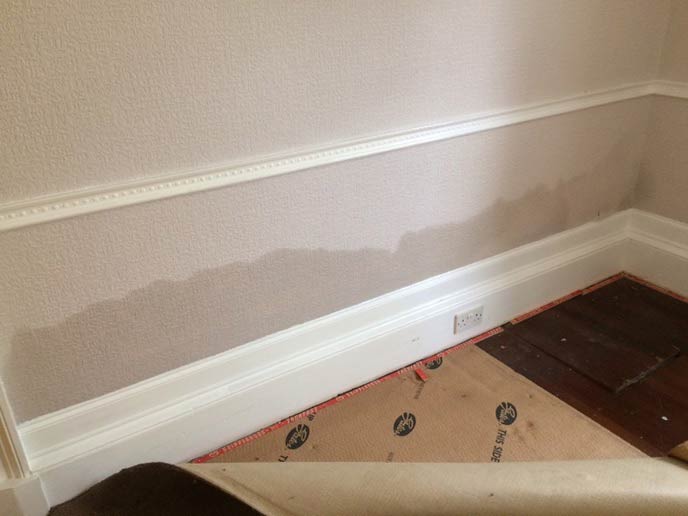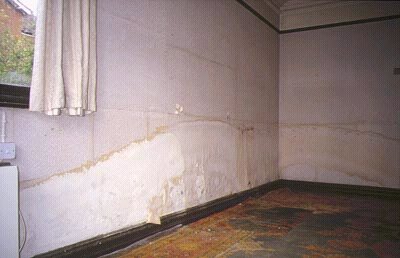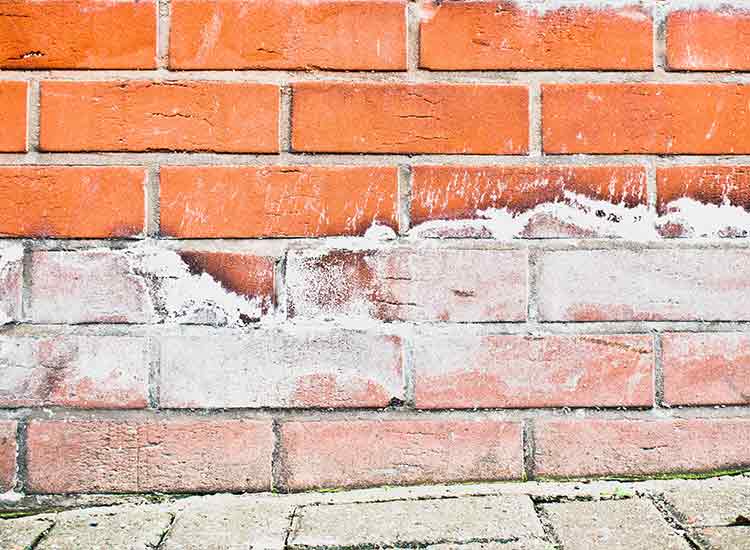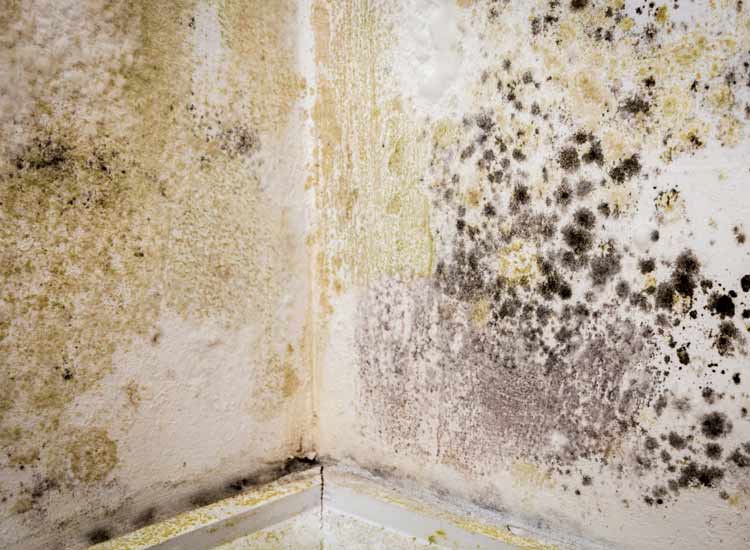What is Rising Damp?

Do you suspect that your property has a rising damp problem? This page provides you with a complete guide to explain what is rising damp and helps you to gain a better understanding of the problem you are potentially suffering from. This page will allow you to understand the causes of rising damp, before going into detail regarding the key signs of rising damp which you may have spotted in your property. If you read the information contained on this page and are convinced that you are suffering from a rising damp problem, it is still a good idea to have a professional provide their opinion. Richardson & Starling’s damp specialists will survey the affected area, before then providing you with an accurate diagnosis of the type of damp you are suffering from. Without the relevant experience and qualifications, differentiating rising damp from other damp problems can be very difficult to do as some of the damp symptoms overlap.
What Is Rising Damp?
Rising damp is a type of damp which can impact the lower portion of walls on the ground floor of properties. Accurate diagnosis and the necessary remedial work being carried out swiftly are very important when dealing with a rising damp issue. Rising damp is the upwards flow of water through wall structures. The moisture is sucked from the ground at the base of the wall of your property. Through capillary action, the water rises through the tiny pores in the masonry and travels up through the wall. Ground water contains salts which are carried through the water which is travelling through the wall. These will be left behind even after the water has evaporated. Although rising damp can usually only reach a height of around 1 metre up the wall, salt deposits may be visible higher up. This is due to the evaporation process affected by different wall finishes or the environment at the wall.

What Causes Rising Damp?
Rising damp is a natural damp problem which occurs when moisture from the soil in the ground outside slowly rises through the wall structure. The wall should be protected by an effective damp proof course however if the existing damp-proof course in the property is failing or has been bridged this allows water to rise up the wall. If you are concerned that your damp proof course is failing, we would recommend you seek a fully qualified damp specialist who would evaluate the effectiveness of your damp proof course. A damp-proof course is a waterproof layer in your wall. This layer breaks the capillary action in the pores of the wall, which attracts the damp, therefore stopping damp from rising up your walls. If necessary, our damp specialist can install a new damp-proof course which will prevent your damp problem and stop the issue from developing.Is your damp problem on the ground floor of your property? If the damp is localised to only the lower portion of the walls then it could be a rising damp problem, you are suffering from. It is probable that your existing damp proof course is being bridged or is defective. If your damp proof course has been bridged, it is important to consider if there are any new external changes which may have caused this issue. For example, a new flower bed or a new patio can provide damp with a new route into the property avoiding the lower damp proof course. Simply lowering the ground level below the damp proof course or removing your new external features and allowing the affected area to dry out should solve your issue.
However, there are several other ways that your damp proof course may be bridged. Your internal plaster may be directly connected to the solid floor at the bottom of your internal wall. Your properties cavity wall may have debris within it, which may have been accidentally left by builders at the time of construction. If this debris is higher than the DPC then this can act as a bridge for moisture to travel from the ground, over your DPC and result in rising damp within your properties walls.

It is important for you to note that your damp problem could be easily misdiagnosed and if you are in any doubt you should contact a damp specialist. There could easily be another source of water or damp in your property which you are unaware of. A key sign that rising damp is not the cause of your damp problem is if there is any damp visible more than one metre up your wall. If the damp patches are unevenly distributed this indicated your property could be suffering from a penetrating damp issue instead or as well as rising damp.
Rising Damp Signs
Treatment for rising damp will only work if your damp issue has been correctly diagnosed. The effectiveness of your existing Damp Proofing’s resistance to rising damp can become damaged over time which may result in your property having a rising damp problem. As previously mentioned, the rising damp problem may also be caused by the ground outside being higher than the damp proof course causing bridging.
To the untrained eye, it can be very difficult to pinpoint rising damp as the source of your property’s damp issue. Other damp issues such as condensation or penetrating damp can often present themselves in a very similar manner to rising damp. As a result, it is crucial that you seek a professional diagnosis from a qualified damp proofing surveyor who will be able to conduct an extensive rising damp survey of the affected areas in your property.
However, there are 6 key rising damp signs which you can look out for:
1. Damp Patches Or Tide Marks
Tide marks are the most common symptom of rising damp. Tide marks are caused by the evaporation of the moisture and salts from the ground. You will notice these up to around one metre up the wall above the skirting board. If there are no visible tide marks, damp stains or patches are the other most common sign of rising damp. These patches will tend to be brownish or yellowish and just like tidemarks, these can be one metre up the wall.
2. Salt Within Plaster
As moisture travels from the ground up the wall through capillary action, the water contains salts. These salts are hygroscopic which means when they evaporate to the surface of the wall and attract moisture from the atmosphere which will keep your wall damp. This will often result in walls feeling damp when touched. As water evaporates, tiny particles of salt will leave a residue which will create fluffy white deposits. These salt particles draw moisture from the air which can cause a permanent damp smell in the property. Salt in the plaster coming from the ground is unique to rising damp so if you have spotted this it is very likely you are suffering from rising damp. Although it is best to call upon a diagnosis from a damp specialist so you are 100% sure.

3. Peeling Paint Or Wallpaper
The additional moisture within the wall can result in wallpaper beginning to peel away from the wall. This is most commonly spotted around the skirting board or up to one metre above it. Wallpaper peeling can also be a sign of a penetrating damp or a condensation problem.
4. Rotting Skirting Boards or Flooring Timbers
If your rising damp issue has been left untreated for a considerable period of time, your skirting boards or flooring timbers may begin to rot as a result. Any unprotected timber with moisture content over 20% is at risk of being affected by a wood destroying fungal attack such as Dry or Wet rot and the damp can come from many sources including rising damp.
5. Damp And Musty Smell
This can be one of the easiest ways for you to identify that your property has a damp problem. Even if there are no visible signs of damp in your property it is likely you will be able to smell it. However, you must seek a professional to accurately diagnose the type of damp problem you are suffering from. Different types of damp require different treatments to resolve the issue.
6. Black Mould
Black mould being present above your skirting board is an obvious sign that this area of your property is suffering from damp caused by condensation. If the black mould is only present on the ground floor of the property and is only located on the lower portion of the wall this is a clear indication that it is a condensation problem however there could also be a rising or penetrating damp issue affecting your property as well. This needs accurate diagnosis and the appropriate remedial specification of work to resolve the problem. It is always the best idea to get a damp specialist’s opinion.

Treating Rising Damp
Our damp specialist will carry out an extensive damp survey of the affected area prior to carrying out any remedial work. Our specialists know the importance of an accurate diagnosis to ensure damp issues are resolved properly. With regards to rising damp treatments, the main technique used is either repairing the existing damp proof course or installing an entirely new one. A chemical damp proof course injection is commonly regarded as the timeliest and most cost-efficient way of resolving a rising damp problem. A chemical damp proof course will form a continuous layer of waterproof material which will break the capillary action in the wall pore structure and stop the damp rising above the effective damp proof course.
This procedure is done through a number of small holes being drilled in the wall and waterproofing material being fed through these holes. All plasterwork which has been affected by damp and hygroscopic salts must be stripped in order to ensure that the salt contaminated areas are entirely removed. The salt contaminated plasterwork can be replaced with a renovating plaster or covered with a cavity wall membrane system before re-plastering. If you are intimidated by all of this you don’t need to worry. Our specialists have seen it all before and will know the most effective treatment to administer for your situation.
What to Do Next?
Failure to accurately diagnose the damp problem in your property and carrying out the wrong remedial works to solve the damp problem can result in large amounts of money being wasted. Also, the damp issue will not be resolved and the work will need to be done again properly. Richardson & Starling damp specialists will ensure that this does not happen, by providing a common sense and rational approach to accurately diagnosing and treating your property’s rising damp problem and issuing a GPI approved guarantee to give you peace of mind.Not sure what is causing damp in your home? Contact your local branch for advice or a property survey to regain your peace of mind.
